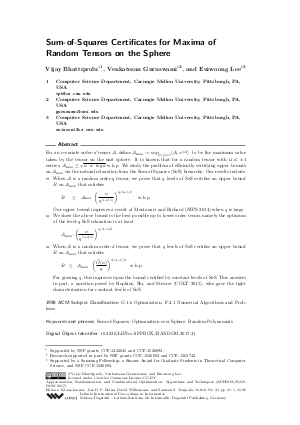Sum-of-Squares Certificates for Maxima of Random Tensors on the Sphere
Authors Vijay Bhattiprolu, Venkatesan Guruswami, Euiwoong Lee
-
Part of:
Volume:
Approximation, Randomization, and Combinatorial Optimization. Algorithms and Techniques (APPROX/RANDOM 2017)
Part of: Series: Leibniz International Proceedings in Informatics (LIPIcs)
Part of: Conference: International Conference on Randomization and Computation (RANDOM)
Part of: Conference: International Conference on Approximation Algorithms for Combinatorial Optimization Problems (APPROX) - License:
 Creative Commons Attribution 3.0 Unported license
Creative Commons Attribution 3.0 Unported license
- Publication Date: 2017-08-11
File

PDF
LIPIcs.APPROX-RANDOM.2017.31.pdf
- Filesize: 0.65 MB
- 20 pages
Document Identifiers
Subject Classification
Keywords
- Sum-of-Squares
- Optimization over Sphere
- Random Polynomials
Metrics
- Access Statistics
-
Total Accesses (updated on a weekly basis)
0PDF Downloads0Metadata Views
Abstract
For an n-variate order-d tensor A, define A_{max} := sup_{||x||_2 = 1} <A,x^(otimes d)>, to be the maximum value taken by the tensor on the unit sphere. It is known that for a random tensor with i.i.d. +1/-1 entries, A_{max} <= sqrt(n.d.log(d)) w.h.p. We study the problem of efficiently certifying upper bounds on A_{max} via the natural relaxation from the Sum of Squares (SoS) hierarchy. Our results include:
* When A is a random order-q tensor, we prove that q levels of SoS certifies an upper bound B on A_{max} that satisfies B <= A_{max} * (n/q^(1-o(1)))^(q/4-1/2) w.h.p. Our upper bound improves a result of Montanari and Richard (NIPS 2014) when q is large.
* We show the above bound is the best possible up to lower order terms, namely the optimum of the level-q SoS relaxation is at least
A_{max} * (n/q^(1+o(1)))^(q/4-1/2).
* When A is a random order-d tensor, we prove that q levels of SoS certifies an upper bound B on A_{max} that satisfies B <= A_{max} * (n*polylog/q)^(d/4 - 1/2) w.h.p. For growing q, this improves upon the bound certified by constant levels of SoS. This answers in part, a question posed by Hopkins, Shi, and Steurer (COLT 2015), who tightly characterized constant levels of SoS.
Cite As Get BibTex
Vijay Bhattiprolu, Venkatesan Guruswami, and Euiwoong Lee. Sum-of-Squares Certificates for Maxima of Random Tensors on the Sphere. In Approximation, Randomization, and Combinatorial Optimization. Algorithms and Techniques (APPROX/RANDOM 2017). Leibniz International Proceedings in Informatics (LIPIcs), Volume 81, pp. 31:1-31:20, Schloss Dagstuhl – Leibniz-Zentrum für Informatik (2017)
https://doi.org/10.4230/LIPIcs.APPROX-RANDOM.2017.31
BibTex
@InProceedings{bhattiprolu_et_al:LIPIcs.APPROX-RANDOM.2017.31,
author = {Bhattiprolu, Vijay and Guruswami, Venkatesan and Lee, Euiwoong},
title = {{Sum-of-Squares Certificates for Maxima of Random Tensors on the Sphere}},
booktitle = {Approximation, Randomization, and Combinatorial Optimization. Algorithms and Techniques (APPROX/RANDOM 2017)},
pages = {31:1--31:20},
series = {Leibniz International Proceedings in Informatics (LIPIcs)},
ISBN = {978-3-95977-044-6},
ISSN = {1868-8969},
year = {2017},
volume = {81},
editor = {Jansen, Klaus and Rolim, Jos\'{e} D. P. and Williamson, David P. and Vempala, Santosh S.},
publisher = {Schloss Dagstuhl -- Leibniz-Zentrum f{\"u}r Informatik},
address = {Dagstuhl, Germany},
URL = {https://drops.dagstuhl.de/entities/document/10.4230/LIPIcs.APPROX-RANDOM.2017.31},
URN = {urn:nbn:de:0030-drops-75808},
doi = {10.4230/LIPIcs.APPROX-RANDOM.2017.31},
annote = {Keywords: Sum-of-Squares, Optimization over Sphere, Random Polynomials}
}
Author Details
References
-
Boaz Barak, Fernando G. S. L. Brandao, Aram W. Harrow, Jonathan Kelner, David Steurer, and Yuan Zhou. Hypercontractivity, sum-of-squares proofs, and their applications. In Proceedings of the forty-fourth annual ACM symposium on Theory of computing, pages 307-326. ACM, 2012.

-
Boaz Barak, Jonathan A. Kelner, and David Steurer. Rounding sum-of-squares relaxations. In Proceedings of the 46th Annual ACM Symposium on Theory of Computing, pages 31-40. ACM, 2014.

-
Boaz Barak, Jonathan A. Kelner, and David Steurer. Dictionary learning and tensor decomposition via the sum-of-squares method. In Proceedings of the Forty-Seventh Annual ACM on Symposium on Theory of Computing, pages 143-151. ACM, 2015.

-
Boaz Barak and David Steurer. Sum-of-squares proofs and the quest toward optimal algorithms. arXiv preprint arXiv:1404.5236, 2014.

- Vijay Bhattiprolu, Mrinalkanti Ghosh, Venkatesan Guruswami, Euiwoong Lee, and Madhur Tulsiani. Weak decoupling, polynomial folds, and approximate optimization over the sphere. Electronic Colloquium on Computational Complexity (ECCC), 23:185, 2016. URL: https://eccc.weizmann.ac.il/report/2016/185/.
-
Vijay Bhattiprolu, Venkatesan Guruswami, and Euiwoong Lee. Certifying random polynomials over the unit sphere via sum of squares hierarchy. arXiv preprint arXiv:1605.00903, 2016.

-
Fernando G. S. L. Brandao and Aram W. Harrow. Quantum de finetti theorems under local measurements with applications. In Proceedings of the forty-fifth annual ACM symposium on Theory of computing, pages 861-870. ACM, 2013.

-
S. Charles Brubaker and Santosh S. Vempala. Random tensors and planted cliques. In Approximation, Randomization, and Combinatorial Optimization. Algorithms and Techniques, pages 406-419. Springer, 2009.

-
Alan Frieze and Ravi Kannan. A new approach to the planted clique problem. In LIPIcs-Leibniz International Proceedings in Informatics, volume 2. Schloss Dagstuhl-Leibniz-Zentrum für Informatik, 2008.

-
Rong Ge and Tengyu Ma. Decomposing overcomplete 3rd order tensors using sum-of-squares algorithms. Approximation, Randomization, and Combinatorial Optimization. Algorithms and Techniques, page 829, 2015.

-
Samuel B. Hopkins, Pravesh K. Kothari, Aaron Potechin, Prasad Raghavendra, Tselil Schramm, and David Steurer. Personal communication, 2017.

-
Samuel B. Hopkins, Jonathan Shi, and David Steurer. Tensor principal component analysis via sum-of-square proofs. In Proceedings of The 28th Conference on Learning Theory, pages 956-1006, 2015.

-
Pravesh K. Kothari, Ryuhei Mori, Ryan O'Donnell, and David Witmer. Sum of squares lower bounds for refuting any CSP. In Proceedings of the 49th ACM Symposium on Theory of Computing, 2017. To appear.

-
Monique Laurent. Sums of squares, moment matrices and optimization over polynomials. In Emerging applications of algebraic geometry, pages 157-270. Springer, 2009.

-
Andrea Montanari and Emile Richard. A statistical model for tensor PCA. In Advances in Neural Information Processing Systems, pages 2897-2905, 2014.

-
Prasad Raghavendra, Satish Rao, and Tselil Schramm. Strongly refuting random CSPs below the spectral threshold. In Proceedings of the 49th ACM Symposium on Theory of Computing, 2017. To appear.

-
Barry Simon. The classical moment problem as a self-adjoint finite difference operator. Advances in Mathematics, 137(1):82-203, 1998.

- R. Tomioka and T. Suzuki. Spectral norm of random tensors. ArXiv e-prints, July 2014. URL: http://arxiv.org/abs/1407.1870.
